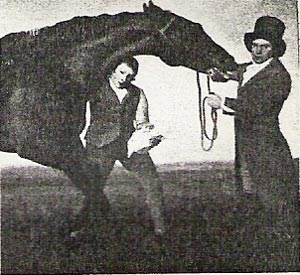A Little History
For 300 years the Hambleton Inn has been Yorkshire's most Sporting Inn.
The White Horse, at Kilburn, just below Hambleton, symbolises the centuries old racing tradition of the area, with the Hambleton Inn at its heart.
The Hambleton plateau was the finest natural racecourse in the country. It was second in importance only to Newmarket until its then remote location, beside the drovers' road from Scotland to York, led the racing to move to York and Richmond in 1776. The winning post, a stone obelisk with a sundial, was a Yorkshire icon. The Hambleton Gold Cup was placed on its top.
The Hambleton racing tradition survives. Sir Noel Murless trained here until 1947 with national achievements. Horses are still successfully prepared on the gallops under the guidance of Kevin Ryan and Bryan Smart.
In past times cock fighting was practiced in the hotel yard, with the bets placed upon the mounting block steps.
Hambleton Racecourse
Hambleton racecourse had the most prestigious race meetings in Yorkshire during the 17th and 18th centuries. It was where the great northern breeders, who founded the Thoroughbred breed, tried out their prize stock. Although at an elevation of 1000 feet, it was a natural racetrack, probably the best in the country, with a 3 mile stretch of flat ancient turf, from Sneck Gate at the top of Boltby Bank which rarely dried out in summer, reducing danger to the horses and riders. Although access was difficult, this did not deter the early sportsmen who were used to travelling long distances on horseback. Most arrived from Thirsk and climbed Boltby Bank or travelled along a path from Malton. The old drovers' road running north/south beside the track enabled Durham and Northumbrian contenders a relatively easy route.
The origins of racing at Hambleton are obscure, but Thomas Chaytor, of Croft, in his diary of 1612 , makes an early reference to racing at Hambleton, describing a contest between mares of George Conyers and Sir William Blaxton. The winning post was beside the Dialstone Inn. Further accommodation was developed at the Hambleton Inn, which became an important training centre. The post itself was a Yorkshire icon, included in paintings by Wootton set at Hambleton., circa 1720.
The main race at Hambleton was for the Royal Gold Cup, donated each year by the Crown. The earliest written record of the race is in Pick for 1715 though it is believed it had been long established, probably initiated as part of the restoration celebrations of Charles II. On 8th August1719 the Gold Cup with 31 entrants attracted more runners than had previously been recorded for any turf event. The Duke of Rutland's Bonny Black won the race. This was the peak of racing at Hambleton, thereafter was a slow decline and the racing eventually transferred to York and Richmond.
The course thereafter became used solely for training and was popular with the successful Malton and Middleham trainers, especially in the summer when their own gallops had dried out. It was utilised in the final preparation of northern entrants for the English Classics where northern horses were particularly successful in the first half of the 19th century. The area today continues to be a successful training ground with active stables under the guidance of Bryan Smart and Kevin Ryan.

The great horse Hambletonian
Won his first race at Hambleton.
He was famous for winning the match race with Diamond, in 1799, at Newmarket. Half of Yorkshire went south to cheer him on and collect their winnings - over £200,000 was wagered - a colossal sum for the time.

It took the form of a stone obelisk with a sundial. It was usual to place the Gold Cup on the top and attach the scales for weighing the jockeys to its structure. The base is still retained locally.
